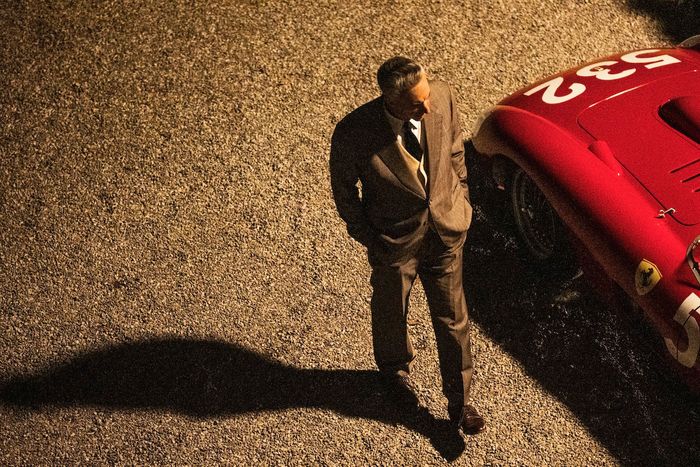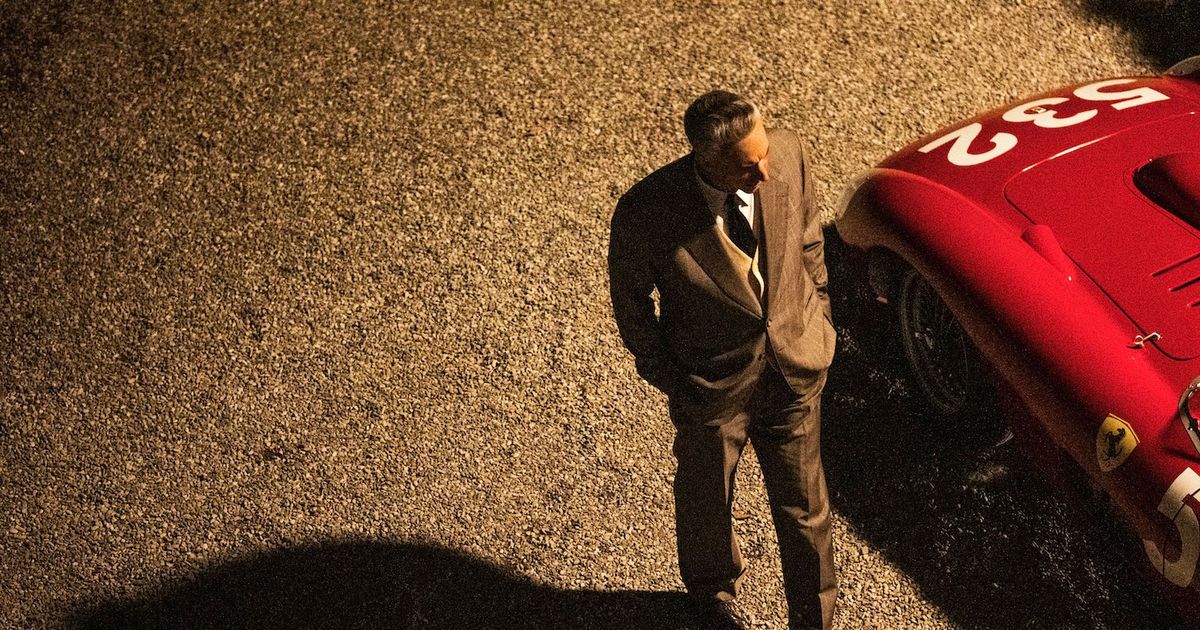
Michael Mann’s long-gestating movie is elegant and restless, with a sense throughout that something horrific is lurking around each corner.
Photo: Lorenzo Sisti
This review was originally published on August 31 out of the Venice Film Festival. We are recirculating it now timed to Ferrari’s theatrical debut. Be sure to also check out our In Conversation with director Michael Mann.
Michael Mann’s rip-roaring Ferrari begins in unlikely silence. Early one morning, Enzo Ferrari (Adam Driver) wakes up in bed next to his mistress, Lina Lardi (Shailene Woodley), and quietly checks the time. He softly pulls a blanket over their sleeping young son, Piero. Then, he gently pushes his car out of the driveway so as not to make a sound. Ferrari, the great master of speed and screaming engines, the ruthless racing impresario who will admonish his drivers to “brake later,” is so tender with his family — this family, his other family, the one which he’s juggling alongside his marriage to the long-suffering Laura Ferrari (Penelope Cruz), who still happens to be an equal partner in his automotive business.
Ferrari takes place over a few pivotal months in 1957, a key year in the automaker’s life and career. The business is drowning in debt and his attorney is recommending he sell to an automotive giant like Ford or Fiat. Ferrari cars have stumbled on the race track. His local rival, Maserati, has just brought in the French driver Jean Behra to set new records. Perhaps more importantly, Enzo and Laura have just lost their son, Dino. Laura knows about Enzo’s many infidelities, but she does not know that he has a whole other family with Lina. Meanwhile, Piero is to be confirmed in a few weeks and still doesn’t know what his last name is. Enzo simply asks if the confirmation can be delayed. “Say he’s lost his faith in god,” he tells Lina. When it comes to his private life, the man is all evasion and avoidance.
The film has a circular structure, evoking the sense that time has stood still in the Ferrari headquarters in Maranello. You would never guess that outside this quaint town, Italy’s postwar boom is charging along — that in Rome and Milan, the Marcello Mastroiannis of the world are lost in the swirl of la dolce vita. Nearby in the city of Modena, a priest solemnly addresses a congregation, many of them car-factory workers, and tells them that if Jesus lived in their time he would not be a carpenter but a metalworker. “The nature of metal,” the priest mulls. “How it can be honed and shaped with your skills into an engine with power to speed us through the world.” Right there in church, the men discreetly pull out their stopwatches as they hear the distant echo of a starting gun, and quietly check the time while the congregants take the sacrament. It’s all the same thing. Cars and racing are the religion here. The movie is not subtle about this.
Enzo Ferrari might make the sports cars that have helped fuel Italy’s economic and social revolution, but he himself is trapped in an almost medieval world of grief and stasis. Every day, he and Laura visit the grave of their son — separately. Enzo sits in the quiet mausoleum and talks to his dead boy about the ghosts he sees when he closes his eyes. As he leaves, he passes Laura, who is just arriving in her car; they don’t even exchange glances. She then sits in the silence of her child’s grave and says nothing, just smiles tearfully at the walls. Cruz gets several big moments in the movie, and she nails them, but her best moments are these quiet ones.
Ferrari also recalls the deaths of his close friends in his cars — as he puts it, “in the metal I made.” His closeness to tragedy prompts him to shut himself off to it: “Enzo, build a wall,” he remembers saying to himself. Mann shows us both the power and the horror of this idea. Enzo is almost comical in his refusal to indulge in grief or shame; early on, he responds to the sudden death of a driver by simply asking the next guy in line to come in tomorrow. Mann doesn’t shy away from showing the consequences of this kind of hard-nosed determination. One climactic moment is so shocking and gruesome you might never want to enter a car again.
As Enzo, Adam Driver somehow manages the impossible. Ferrari was 59 years old when the events of this movie took place; the actor is just shy of 20 years younger. He’s got convincing jowls and worry lines, and he absolutely goes to town on the Italian accent. Some performances are technically perfect but devoid of life: Christian Bale in Vice comes to mind, an uncanny reconstruction of Dick Cheney with zero dimensionality. Driver’s Ferrari is the opposite: technically imperfect, perhaps, but wonderfully alive. You can’t take your eyes off him. In the hands of a less confident actor, this could have been a disaster, theatrical and awkward and unreal. But Driver makes Ferrari — this stolid, strapping wall of a man, towering over everyone around him and always commanding our attention — something indelible, a force not so much of nature as steel, asphalt, and death. In his later years, Enzo Ferrari was a construct, a godlike figure purposefully presented as cold, refined, and ruthless. This is that Ferrari captured mid-transformation. The people around him call him commendatore — a not-uncommon title of honor in Italy at the time. But one is also reminded of Il Commendatore, the great haunted statue that comes to life at the end of Mozart’s Don Giovanni, a symbol of divine retribution and judgment.
Opera is perhaps the key to Mann’s film. An opera company even comes to town. (Ferrari complains that they’re out of tune. “More in tune than your cars in Monaco last summer,” they retort.) During a performance, the entire town sits and listens, and each character contemplates a long-ago moment in time. Enzo thinks back on playing with his son Dino. Lina remembers telling Enzo she’s pregnant. Ferrari’s mom imagines the day her other son went off to war to die. Laura recalls a warm family moment back when her family was intact. Everybody’s lost in their own past. The only way out is forward.
The director has been trying to realize this project since the mid-1990s (the credited screenwriter, Troy Kennedy Martin, died in 2009), and one can almost imagine this as a film Mann might have made around that time. Stylistically, Ferrari is much more classical and composed than the digital abstractions of Blackhat (2015), Miami Vice (2006), and Collateral (2004). It has something of the unsettling serenity of Manhunter (1986) and the character detail of Heat (1995). Part of the score from The Insider (1999) even makes a memorable appearance. Like those earlier films, Ferrari is elegant and restless, with a sense throughout that something horrific might be lurking around each corner. And when the director straps his cameras on those cars and sends them on their way, the picture transforms into something more visceral and chaotic, a fever dream (or maybe a nightmare) of speed and smoke.
Mann has always balanced the intimate with the epic. Films like Heat and Miami Vice are as much about men and women and what they say to each other as they are about standoffs and shootouts and getaways. In Ferrari, he might have found the purest expression of this idea. To paraphrase a famous line from Heat, it’s a movie about metals. About the hard and smooth metal that is required, both practically and figuratively, and the way that metal can twist and bend and destroy the people that come in contact with it. In life, as it is in racing.
See All
